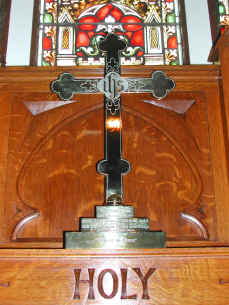Feast
of the Holy Cross
14
September 335
 During
the reign of Constantine, first Roman Emperor to profess the Christian faith,
his mother Helena went to Israel and there undertook to find the places
especially significant to Christians. (She was helped in this by the fact that
in their destructions around 135, the Romans had built pagan shrines over many
of these sites.) Having located, close together, what she believed to be the
sites of the Crucifixion and of the Burial (at locations that modern
archaeologists think may be correct), she then had built over them the Church of
the Holy Sepulchre, which was dedicated on 14 September 335. It has become a day
for recognizing the Cross (in a festal atmosphere that would be inappropriate on
Good Friday) as a symbol of triumph, as a sign of Christ's victory over death,
and a reminder of His promise, "And when I am lifted up, I will draw all
men unto me." (John 12:32)
During
the reign of Constantine, first Roman Emperor to profess the Christian faith,
his mother Helena went to Israel and there undertook to find the places
especially significant to Christians. (She was helped in this by the fact that
in their destructions around 135, the Romans had built pagan shrines over many
of these sites.) Having located, close together, what she believed to be the
sites of the Crucifixion and of the Burial (at locations that modern
archaeologists think may be correct), she then had built over them the Church of
the Holy Sepulchre, which was dedicated on 14 September 335. It has become a day
for recognizing the Cross (in a festal atmosphere that would be inappropriate on
Good Friday) as a symbol of triumph, as a sign of Christ's victory over death,
and a reminder of His promise, "And when I am lifted up, I will draw all
men unto me." (John 12:32)
The Christian custom of tracing the sign of the cross on persons and things as a sign of blessing is very old. Justin Martyr, in approximately AD 150, refers to the cross as a standard Christian symbol, but not explicitly to tracing the sign of the cross as a devotional gesture. Tertullian, writing around AD 211, says that Christians seldom do anything significant without making the sign of the cross. Certainly by his time the practice was well established.
What is the significance of the sign of the cross? Well, in the first place, we
often place our initials or other personal mark on something to show that it
belongs to us. The cross is the personal mark of Our Lord Jesus Christ, and we
mark it on ourselves as a sign that we belong to Him, just as in the book of
Revelation, as noted above, the servants of God are sealed or marked on their
foreheads as a sign that they are His.
Again, as one preacher has said, if you were telling someone
how to make a cross, you might say, "Draw an I and then cross it out."
As we make the sign, we first draw a vertical stroke, as if to say to God,
"Lord, here am I." Then we cancel it with a horizontal stroke, as if
to say, "Help me, Lord, to abandon my self-centeredness and self-will, and
to make you the center of my life instead. Fix all my attention and all my
desire on you, Lord, that I may forget my self, cancel my self, abandon myself
completely to your love and service."
A full four centuries before Jesus was born, the great pagan philosopher, Plato, had come to see that, in a world so broken by pride and perverted by power as this one, a perfectly just man would be condemned by his contemporaries as being outstandingly wicked. What would become of such a person, Plato wondered; and the answer he gave was that the perfectly just man ‘will be scourged, tortured and imprisoned, his eyes will be put out, and after enduring every humiliation he will be crucified.’
On this Holy Cross Day, we recognise the truth of what Plato said. We understand that, for such a world as ours, no Saviour would do but a Saviour hanging on a cross; and the Lord’s words make sense that, ‘When I am lifted up from the earth, I shall draw all men to myself.’ And so we come to him. We gladly acknowledge that he, and he alone, precisely because he was crucified, is our Saviour and our Lord, and we accept his invitation of grace: ‘If any man would come after me, let him deny himself and take up his cross and follow me.’Text adapted from James
Kiefer's Christian Biographies, Credo
Cymru
Image from Saint James' Church, Manotick